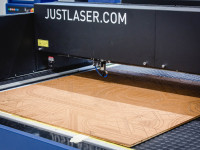The technology behind the laser
Functionality made understandable
Laser technology is a fascinating and versatile invention that is used in many areas of everyday life and in various industries. In order to fully exploit the potential of a laser, it is important to understand how it works.
Introduction to laser technology
The word "laser" is an acronym for "Light Amplification by Stimulated Emission of Radiation", which translates as "light amplification by stimulated emission of radiation". A laser generates a very narrow, intense beam of light. In contrast to conventional light sources, whose light spreads out in all directions, laser light is highly concentrated and coordinated, which makes it very powerful.
The functioning of a laser is based on three essential components: an active medium, an energy source and a resonator.
Active medium:
The active medium in the laser can be solid (such as crystal or glass), liquid or gaseous. This medium is the key to generating laser radiation. It consists of atoms or molecules that are capable of emitting light.
Energy source:
The energy source, also known as the pump source, supplies the energy required to excite the active medium. This can be done by electric current, light from another light source or by a chemical reaction.
Resonator:
The resonator consists of two or more mirrors arranged around the active medium. One of these mirrors is partially transparent. The resonator amplifies the light emitted by the active medium and feeds it back, resulting in further light amplification.
The active medium is the place where light amplification takes place. Here, electrons are moved to a higher energy state by supplying energy and emit a light pulse when they fall back. The pump source supplies the energy required to initiate this process. The resonator consists of two mirrors and optical elements such as lenses or crystals, which amplify the light in the laser and bring it to a specific wavelength. These components work together perfectly to generate the desired laser beam. Due to the coherence of the light, a laser is particularly precise and efficient - properties that make it indispensable for many applications.
The basics of light amplification in lasers
An important component of laser technology is light amplification. Here, a weak light signal is amplified by passing it through an active medium. This usually consists of a material such as a gas or a crystal, which is excited by a pump source. This excitation raises electrons to higher energy levels and releases energy as they fall back, which is emitted in the form of photons. These photons can now excite further electrons and thus generate an amplification of the light signal.
It is important that the light signal hits the active medium at a certain frequency in order to generate a resonance and thus achieve maximum amplification.
How does light amplification work in the active medium?
The actual light amplification takes place in the active medium of a laser. This is a material that is excited by a pump source and thus emits high-energy photons. These photons excite other atoms in the active medium, triggering a cascade of emissions.
These photons are amplified and focused by the laser's resonator until a high-energy laser beam is produced. The type of active medium is decisive for the wavelength and quality of the laser beam.
Common materials include semiconductors or crystals such as ruby crystals or neodymium-doped yttrium-aluminum garnets (Nd:YAG). An important challenge in the development of high-power lasers is to optimize the active medium so that it works as efficiently as possible while withstanding extreme loads. The higher the power of a laser, the greater the demands on the active medium.
The interaction of mirrors and optical elements in the resonator
A crucial part of the technology takes place in the laser's resonator. This is where the light beams are amplified and focused before they emerge from the device. The interaction of mirrors and optical elements in the resonator is of great importance here.
The mirrors are arranged in such a way that the light is reflected back and forth several times in order to achieve maximum amplification. The mirrors must be aligned so precisely that the light always falls exactly on the point where it is to be amplified.
The optical elements in the resonator also help to ensure that the light is optimally focused. They ensure that all wavelengths of the laser light are in phase and therefore remain coherent - an important factor for many laser technology applications.
Overall, it can be said that the technology behind the laser is extremely complex and many different components have to interact with each other to ensure effective operation.
Why is coherence important for a laser?
An important aspect of how a laser works is the coherence of the light. Coherence means that the light oscillates in a certain phase and wavelength and therefore has a uniform beam direction. Without this coherence, the laser light would scatter uncontrollably and therefore lose power.
In order to maintain coherence in the resonator, high-precision mirrors are used to repeatedly reflect and amplify the light.
How does a laser work?
The way a laser works can be described in several steps:
Suggestion:
First, the active medium is excited by the energy source. This causes the electrons in the atoms or molecules of the medium to be raised to a higher energy level.
Stimulated emission:
When these excited electrons fall back to their original level, they emit photons - particles of light. This emission of photons is known as stimulated emission.
Light amplification:
The emitted photons move back and forth between the mirrors of the resonator. In doing so, they stimulate further emissions in the active medium, which leads to an amplification of the light.
Generation of the laser beam:
Finally, some of the amplified light leaves the resonator through the partially transparent mirror. This emerging beam of light is the laser beam.
Applications of laser technology in various areas
Laser technology has made enormous progress in recent decades and is now indispensable in many areas. One example of this is medicine, where lasers are used in ophthalmology or can be used to remove tumors.
Laser applications have also found their way into industry: They are used for cutting and welding metals or for the production of micro-components.
The possibilities offered by the use of laser technology are virtually unlimited - one reason why researchers and engineers are always looking to develop and optimize new laser-based technologies.
There are challenges in the development of high-power lasers
There are a number of challenges to overcome in the development of high-power lasers. The materials from which the various components of the laser have to be manufactured play an important role. The high power and energy densities that can be achieved in a high-power laser require materials with extremely high purity and strength.
The cooling of the laser is also an important factor, as a large amount of heat is generated at higher power levels that needs to be dissipated. In addition, particularly high precision and stability must be guaranteed in the manufacture of high-power lasers in order to ensure optimum functionality.
Another aspect is safety: when working with high-power lasers, special precautions are necessary to avoid injuries caused by direct or indirect irradiation.
Despite all these challenges, laser technology has developed enormously in recent decades and is now used in many areas such as medicine, industry and research.
The technology behind the laser is a fascinating interplay of physics and engineering. Made understandable, it shows that laser technology is based on clear and comprehensible principles.
This advanced technology has the potential to revolutionize processes in various industries and is a decisive factor for innovation and progress.


